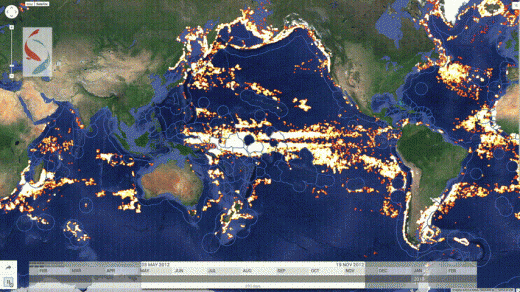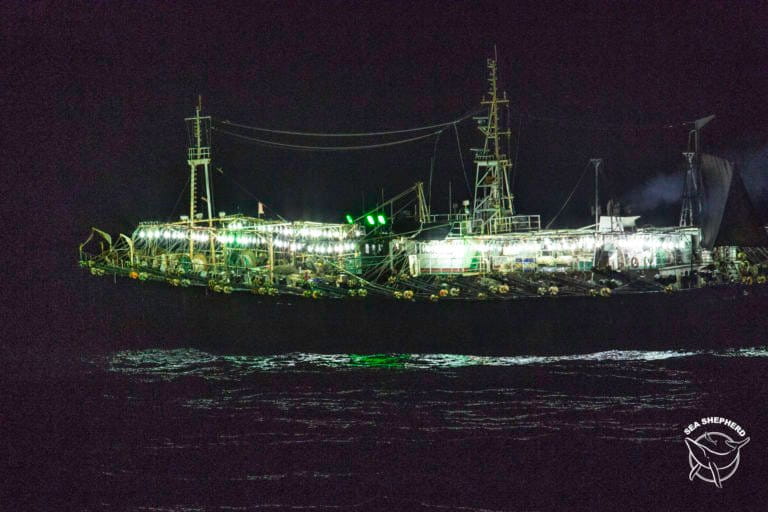https://news.mongabay.com/2018/11/panama-namibia-plan-to-reveal-fishing-fleet-data-via-online-map/?fbclid=IwAR3nemD75XQrx0MzowYQJMYRliMW0MOu5TdWy4BiQ8JCMU29MVB__51Lf5U
Panama, Namibia plan to reveal fishing fleet data via online map
- Panama and Namibia have planned to publicly share information on their fishing fleet in their waters via the open-access mapping tool by Global Fishing Watch (GFW).
- Both nations say such a move would be crucial in improving transparency in fisheries management and protecting their oceans.
- GFW’s mapping platform provides both general data for the public and more detailed information seen only by authorities.
- The tool helps identify if a boat is fishing during the closed season of a particular species; if it enters an unauthorized area; or if it sails into a protected area.
NUSA DUA, Indonesia — In a bid to beef up fisheries security, Panama and Namibia have announced their intentions to make information on the location of fishing boats in their waters publicly available via the open-access platform Global Fishing Watch (GFW).
Representatives of the two nations recently praised GFW’s mapping service for helping governments tackle illegal, unreported and unregulated (IUU) fishing. GFW tracks the location and activities of commercial fishing boats using signals from tracking devices that many fishing vessels carry: either the Automatic Identification System (AIS) that broadcasts publicly, or the Vessel Monitoring System, (VMS) which is proprietary to individual nations.
“We need to bring more openness … We need to democratize our global fisheries by becoming transparent,” Bernhardt Esau, Namibia’s minister of fisheries, said on Oct. 30 at a panel discussion during the Our Oceans Conference in Nusa Dua, Bali, Indonesia.
“Namibia should — though we’re not the starting point — be joining Peru and Indonesia,” he said.

Founded in 2015 as a partnership between Google, the conservation group Oceana and the nonprofit watchdog group SkyTruth, which uses tools like satellite imagery to monitor environmental issues, GFW provides a mapping platform that allows anyone to view or download data and investigate fishing activity in near real-time, for free.
In June 2017, Indonesia became the first country to share its proprietary VMS data with GFW; Peru soon announced that it would follow the Southeast Asian country’s move. Both Peru and Indonesia are among the world’s top 10 fishing nations. Last month Peru officially started sharing VMS data on commercial fishing vessels in its waters.
“I’d like to express Panama’s interest to join this effort to share our data. We will upon my return to Panama discuss further with the relevant parties,” Panamanian Vice President Isabel de Saint Malo de Alvarado at the same panel discussion where Esau of Namibia made his remarks.
“I understand that steps have already been taken in this light, I really think this is the way,” she added.
Last month, Panama was one of four countries from Latin America that signed a memorandum of understanding with GFW and the environmental foundation PACIFICO to develop a joint strategy to improve transparency in fisheries management at the regional level. But the MOU stopped short of committing the countries to sharing fishing boats’ data with GFW.

GFW welcomed Panama and Namibia’s interest in sharing their proprietary vessel tracking data with the platform.
“This is good news because normally countries have been feeling the pressure to be more transparent,” Tony Long, chief executive officer of GFW, told Mongabay. “I’m really pleased that they’re going to consider it.”
Long also noted that more countries have expressed interest in partnering with his organization, and some are already taking steps toward publishing their fishing-fleet data on GFW’s online mapping platform. In May, for example, Costa Rica committed to publicly sharing its VMS data via the NGO’s map, but it has not yet done so.
Long said the trend of more countries showing interest in using and contributing to GFW’s mapping tool was due to the “large” cost of traditional enforcement: “You need a very large efficient coastguard, you need a lot of information.”
He added that countries that have used GFW’s tool or expressed interest in sharing their fishing-fleet data all have huge marine resources to protect, a difficult prospect through traditional enforcement.
GFW’s mapping platform provides both general data for the public and more detailed information seen only by authorities. The public can learn, for example, if a boat is fishing during the closed season of a particular species; if a boat enters an unauthorized area; or if it sails into a protected area. The system also allows users to know if maritime agreements between countries are being fulfilled.
“People have started to realize by sharing data openly, it reduces their issues because they can recognize the vessels that have been compliant. They can also show on the global stage that they’ve taken responsibility,” Long said. “Bring it out into the open. It takes away potential corruption; it hides any lies or misleading; and the vessels that are in the dark suddenly become very obvious.”

In 2016, Namibia produced 504,468 metric tons of fish, and Panama produced 153,258, according to World Bank data.
There are currently 203 fishing vessels licensed to operate in the Namibian Exclusive Economic Zone, 80 percent of which are Namibian-owned, according to the country’s fisheries ministry. The southern African nation is expected to increase its fleet, with plans to start building its own fishing boats.
However, the country faces the twin threats of overcatching and illegal fishing, Esau noted, and officials hope that joining GFW will help curtail them. “Illegal fishing of the high seas is coming into our EEZ … We need to democratize our global fisheries by becoming transparent,” he said.
Meanwhile, Panama provides an open registry which offers many benefits such as easier registration (typically online), zero income taxes levied on owners, and the ability to employ cheaper foreign labor.
Critics of the scheme say it enables shipowners to hide their true identities and leads to the lax enforcement of fishing regulations. The country currently has the world’s largest fleet, with more than 8,000 vessels registered under the Panamanian flag. But Saint Malo noted that only about 3 percent of the fleet was dedicated to fisheries.
The country also has a big problem with IUU fishing. A 2014 study estimated that almost 40 percent of Panama’s total catch between 1950 and 2010 — including tuna, lobster, shellfish and shark — was unaccounted for. The discrepancy was due to minimal reporting of bycatch by commercial vessels; a dearth of data from recreational, subsistence and artisanal fisheries; and illegal fishing by foreign vessels, the report suggested.
The researchers recommended a reorganization of the fishing sector to include better monitoring, planning and surveillance of fishing zones — issues that joining GFW could help the country address.
“We are constantly looking to ensure that vessels registered under Panama’s flag abide by global norms, by global legislation and abide by the norms of their own sector,” Vice President Saint Malo said.
“[To] share the data on where they’re fishing, how they’re fishing, where they’re going, it’s something that will definitely support our efforts as a country, as a responsible country, to ensure that vessels registered under our flag perform correctly,” she added.

Image banner of Chinese squid boats offloading catch to a reefer vessel. Image by Simon Ager for Sea Shepherd.
FEEDBACK: Use this form to send a message to the author of this post. If you want to post a public comment, you can do that at the bottom of the page.
沒有留言:
張貼留言